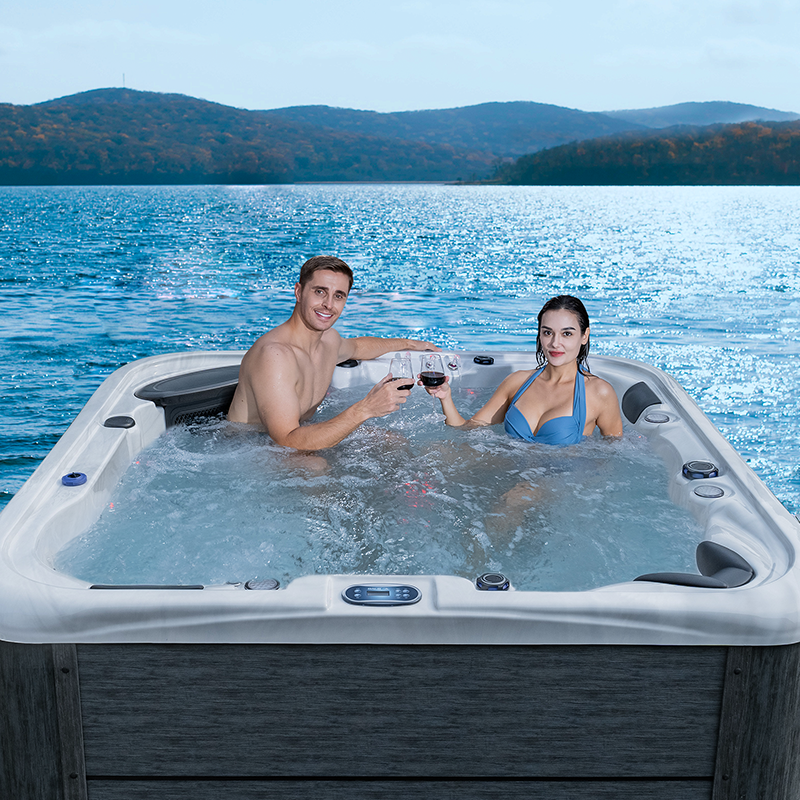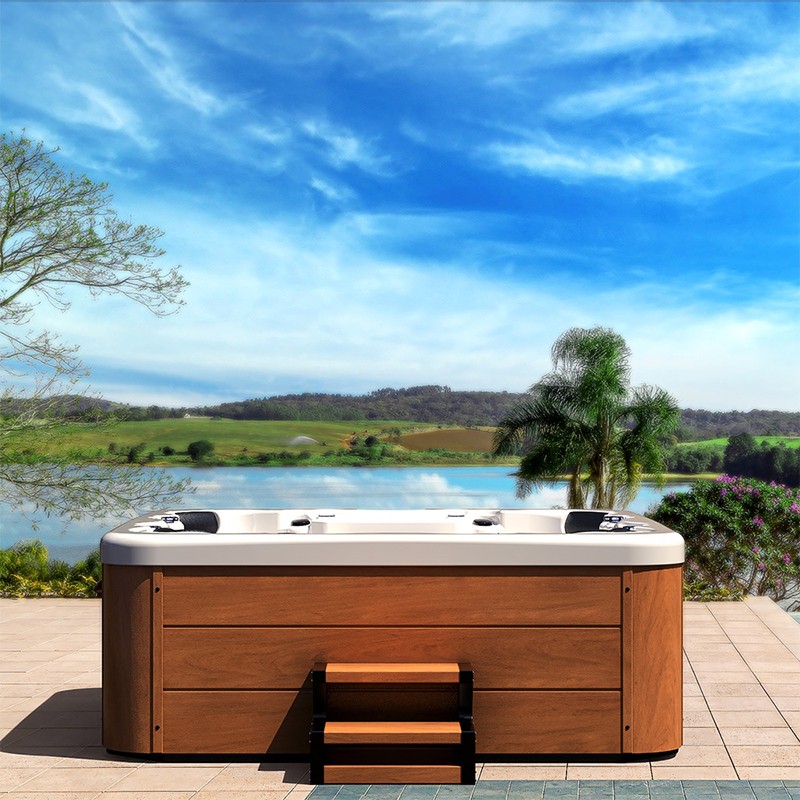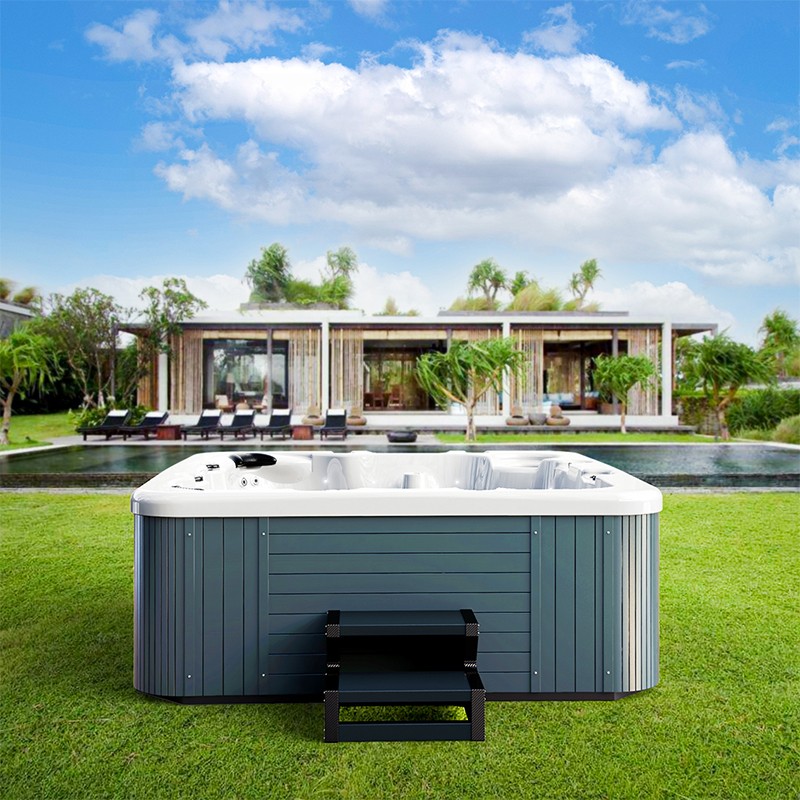
What is CYA in an outdoor spa hot tub?
2025-11-19 15:30For frequent users of outdoor spa hot tubs, maintaining stable water quality is the most crucial aspect of daily maintenance.
Familiar water quality indicators usually include pH, chlorine concentration, alkalinity, and hardness. However, in the professional spa maintenance field, there is another very important but often overlooked chemical indicator—CYA (Cyanuric Acid).
Many users see the "CYA" item when testing outdoor spa hot tub water quality but don't know its true meaning. Is it a harmful substance? Or a protective component? Why does it affect the effectiveness of chlorination?
This article will systematically and deeply answer these questions, giving you a clear understanding of what CYA in outdoor spa hot tubs is, why it's important, and how to properly control its content.

What is CYA (Cyanuric Acid)?
1. Chemical Definition of CYA
CYA, short for Cyanuric Acid, is a white crystalline organic compound, often referred to as a "chlorine stabilizer" or "chlorine protectant."
Its main function is to stabilize chlorine in outdoor spa hot tub water, preventing it from being decomposed by ultraviolet rays in sunlight, thus extending the effective time of chlorine.
In other words:
Without CYA, chlorine disinfectant exposed to direct sunlight outdoors will decompose rapidly in a short time, leading to a decrease in disinfection ability.
However, with an appropriate amount of CYA, chlorine can maintain a longer and more stable bactericidal effect in the water.
2. Why is CYA particularly important for outdoor spa hot tubs?
Unlike indoor spas, outdoor spa hot tubs are exposed to sunlight for extended periods.
Ultraviolet rays decompose chlorine molecules extremely quickly—studies show that under strong sunlight, unprotected chlorine can lose up to 90% of its effectiveness within 2 hours.
Therefore, an appropriate amount of CYA acts like "sunscreen," providing a protective barrier for chlorine, reducing disinfectant waste, and maintaining clean and stable water quality.

Why is it necessary to control the CYA content in outdoor spa hot tubs?
While the presence of CYA does stabilize chlorine, more is not necessarily better.
In fact, excessively high CYA levels severely weaken the bactericidal efficiency of chlorine, leading to water quality deterioration in outdoor spas and hot tubs.
1. The Chemical Relationship Between CYA and Chlorine
Chlorine exerts its bactericidal effect in water primarily as hypochlorous acid (HOCl).
When CYA levels increase, it combines with chlorine to form a chlorocyanuric acid complex, reducing the proportion of free chlorine.
The result is:
Although total chlorine remains in the water, the concentration of effective bactericidal free chlorine decreases, significantly weakening the disinfection effect.
2. Consequences of Excessive CYA Concentration
In outdoor spa hot tubs, if the CYA concentration exceeds the ideal range (typically 30–50 ppm), the following problems will occur:
• Chlorine inactivation: Disinfection speed slows down, and bacteria and algae proliferate easily;
• Turbidity: Increased burden on the filtration system, resulting in green or white turbidity;
• Odor generation: Chlorine reacts with organic matter, producing an irritating odor;
• Increased maintenance costs: More chlorine tablets are needed to achieve the same disinfection effect.
Therefore, the key to controlling CYA concentration is "balance"—it cannot be too low or too high.
How does CYA form in outdoor spa hot tubs?
Many users do not actively add CYA, yet find high concentrations in their tests. This is because CYA often indirectly enters the outdoor spa hot tub water through disinfection products.
1. Chlorine preparations containing stabilizers are the main source
Commonly used chlorine preparations fall into two categories:
• Stabilized chlorine: Contains CYA, such as sodium dichloroisocyanurate (Dichlor) and trichloroisocyanuric acid (Trichlor);
• Unstabilized chlorine: Does not contain CYA, such as calcium hypochlorite (Cal-Hypo) or sodium hypochlorite.
When you use Dichlor or Trichlor as a disinfectant, CYA enters the water along with the chlorine and gradually accumulates.
2. Why does CYA accumulate?
Unlike chlorine, CYA does not disappear with evaporation or be removed by filtration systems.
The only way to reduce it is to replace part or all of the water.
This means that if you use chlorine containing stabilizers for an extended period without changing the water in your outdoor spa hot tub, the CYA level will continue to rise.
What is the ideal range for CYA in an outdoor spa hot tub?
Maintaining a suitable CYA concentration is key to maintaining water quality balance.
✅ Recommended Range:
Usage Environment | Ideal CYA range (ppm) |
| Outdoor spa hot tub | 30–50 ppm |
| Indoor spa | 0–30 ppm |
| Public swimming pool | 30–70 ppm |
For most household outdoor spa hot tubs, 40 ppm is the optimal balance point—sufficient to protect chlorine without weakening its bactericidal effect.

How to test the CYA content in an outdoor spa hot tub?
1. Using test strips
CYA test strips are a simple and effective tool.
Immerse the test strip in the outdoor spa hot tub water for a few seconds and read the value based on the color change.
This method is suitable for daily monitoring, but its accuracy is limited.
2. Using liquid test reagents (titration method)
The liquid test method is more accurate and can accurately read the CYA concentration.
The typical procedure is:
• Take a sample into a test tube;
• Add the reagent and shake well;
• Observe the degree of turbidity and read the corresponding scale.
If the result exceeds 70 ppm, dilution or replacement of the water should be considered.
How to reduce CYA levels when they are too high?
When a high CYA level is detected in an outdoor spa hot tub, immediate measures should be taken to restore balance.
1. Partial Water Replacement (Drain and Refill)
This is the most direct and effective method.
• For example: If the CYA level is 100 ppm, while the ideal level is 50 ppm, approximately half the water volume needs to be replaced.
• Principle: CYA does not evaporate; its concentration can only be reduced through dilution.
2. Switch to Unstable Chlorine
Discontinue the use of Dichlor or Trichlor and switch to Cal-Hypochlorite (calcium hypochlorite) or liquid chlorine.
This maintains effective disinfection without increasing CYA levels.
3. Regular Testing and Maintenance
Test the CYA concentration monthly to ensure it remains stable at around 40 ppm.
If the outdoor spa hot tub is used frequently, it is recommended to replace 1/3 of the water every two months.
What are the effects of low CYA levels?
While high CYA levels weaken chlorination effectiveness, excessively low CYA levels can cause another extreme problem:
1. Chlorine decomposes rapidly under sunlight
Ultraviolet rays in outdoor sunlight quickly destroy chlorine molecules. When the CYA level is below 20 ppm, chlorine can be lost by more than 80% within 2 hours.
This leads to:
• A surge in disinfectant usage;
• Decreased water quality stability in outdoor spa hot tubs;
• A stronger chlorine odor, irritating eyes and skin.
2. Wasted maintenance costs
Low CYA means you need to add chlorine more frequently, increasing operating costs.
Maintaining adequate CYA allows chlorine to achieve its maximum "long-lasting disinfection" effect.
The Interaction Between CYA, pH, and Alkalinity
In the water chemistry system of outdoor spa hot tubs, various parameters are interconnected.
Changes in CYA concentration often indirectly affect pH and total alkalinity (TA)
1. Effect on pH
CYA itself is weakly acidic. When its concentration increases, it will slightly lower the pH of the outdoor spa hot tub water.
If the pH drops too much, it may cause:
• Metal corrosion;
• Aging of seals;
• Skin irritation for users.
Therefore, after adjusting CYA, the pH should be monitored simultaneously to ensure it is maintained between 7.2 and 7.8.
2. Effect on Alkalinity
CYA will "occupy" a portion of the total alkalinity reading, causing deviations in the test results.
For example, if the total alkalinity is measured at 100 ppm, and the CYA at 50 ppm, the actual "effective alkalinity" is only about 70 ppm.
This relationship should be considered during maintenance to ensure overall balance.

How to achieve long-term CYA stability in an outdoor spa hot tub?
To maintain ideal water quality over the long term, it is recommended to establish a scientific maintenance procedure.
1. Use High-Quality Chemicals
Choose reliable brands of chlorine preparations and stabilizers to avoid impurities affecting CYA readings.
2. Establish a Regular Testing System
• Test chlorine, pH, and alkalinity weekly;
• Test CYA concentration monthly;
• Record numerical changes to help determine trends.
3. Regularly Replace a Portion of Water
Drain 1/3 of the water from the outdoor spa hot tub every 2-3 months. This not only regulates CYA but also removes dissolved solids and organic residues.
4. Avoid Overuse of Dichlor
If using Dichlor disinfectant long-term, use an alternation method: Use Dichlor for 2 weeks → then use Cal-Hypo for the next 2 weeks to prevent rapid CYA accumulation.
5. Maintain Good Filtration Circulation
Ensure the outdoor spa hot tub filtration system runs for 2-4 hours daily to ensure even chemical distribution and prevent localized high concentrations.
What Makes LOVIA SPA Different from Other Spa Factories?
LOVIA SPA stands out for its 35+ years of manufacturing experience, advanced production systems, and customer-first philosophy. Our Guangzhou-based factory covers 45,000 square meters and integrates design, molding, testing, and export processes. Buyers benefit from complete in-house production, which reduces costs and ensures consistent quality.
As a professional manufacturer and global supplier, we offer transparent prices, quick quotes, and wholesale discounts.
